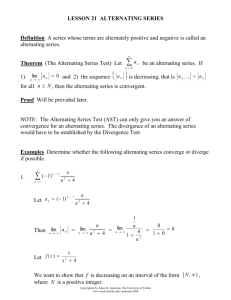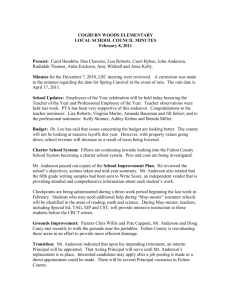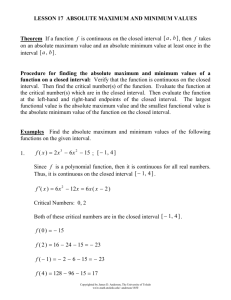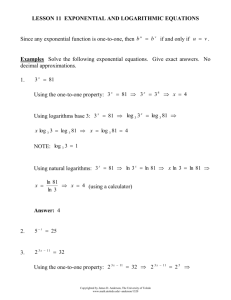Lesson 19 Convergent and Divergent Series
advertisement
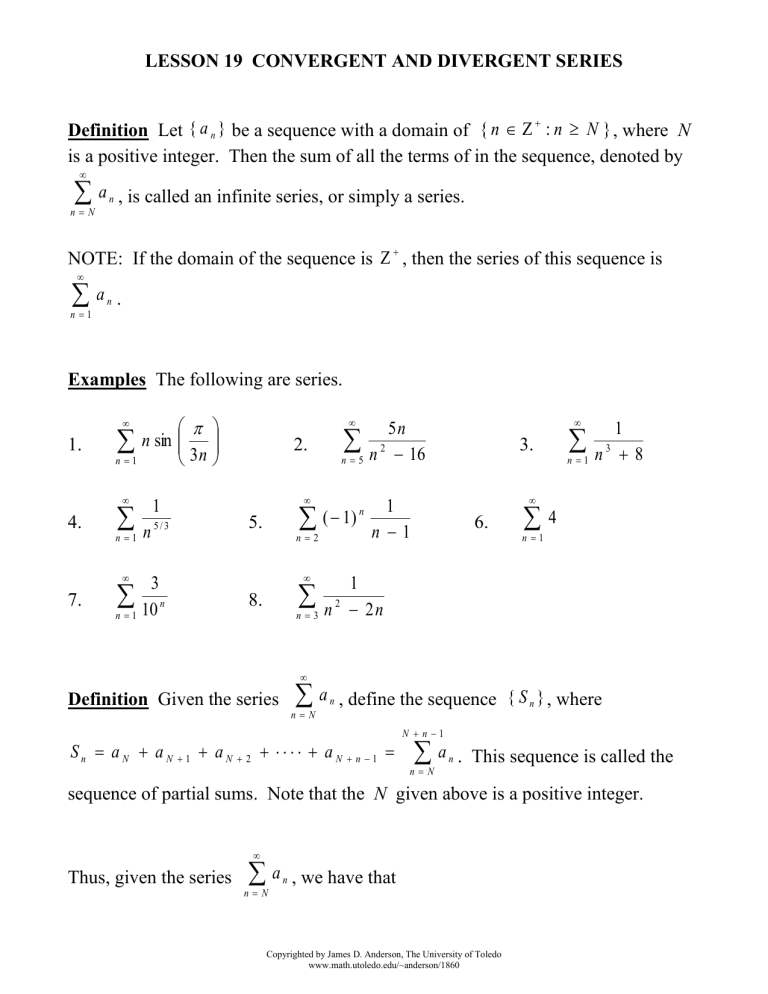
LESSON 19 CONVERGENT AND DIVERGENT SERIES
Definition Let { a n } be a sequence with a domain of { n : n N } , where N
is a positive integer. Then the sum of all the terms of in the sequence, denoted by
a
nN
n
, is called an infinite series, or simply a series.
NOTE: If the domain of the sequence is , then the series of this sequence is
a
n 1
n
.
Examples The following are series.
n sin
3
n
n 1
1.
4.
n
n 1
1
5/3
7.
n5
3.
5.
n
8.
n3
2
n
n 1
1
3
8
1
( 1)
n 1
n2
n
3
n
n 1 10
2.
5n
n 2 16
6.
4
n 1
1
2n
a
Definition Given the series
nN
n
, define the sequence { S n } , where
Sn aN aN 1 aN 2 aN n 1
N n 1
a
nN
n
. This sequence is called the
sequence of partial sums. Note that the N given above is a positive integer.
Thus, given the series
a
nN
n
, we have that
Copyrighted by James D. Anderson, The University of Toledo
www.math.utoledo.edu/~anderson/1860
S1 a N
S 2 a N a N 1 S1 a N 1
S3 aN aN 1 aN 2 S2 aN 2
S4 aN aN 1 aN 2 aN 3 S3 aN 3
S5 aN aN 1 aN 2 aN 3 aN 4 S4 aN 4
.
.
.
Sn aN aN 1 aN 2 aN n 2 aN n 1 Sn 1 aN n 1
.
.
.
Thus, given the series
a
n 1
n
, we have that
S1 a1
S 2 a1 a 2 S1 a 2
S 3 a1 a 2 a 3 S 2 a 3
S 4 a1 a 2 a 3 a 4 S 3 a 4
S 5 a1 a 2 a 3 a 4 a 5 S 4 a 5
.
.
.
S n a1 a 2 a 3 a n 1 a n S n 1 a n
Copyrighted by James D. Anderson, The University of Toledo
www.math.utoledo.edu/~anderson/1860
.
.
.
Definition Given the series
a
nN
n
, whose sequence of partial sums is { S n } , then
S n S , then we say that the series is convergent (or converges, or
if nlim
S n does not exist, then we say that the series is divergent
converges to S.) If nlim
(or diverges.) Note that the N given above is a positive integer.
TERMINOLOGY: S is called the sum of the series
a
nN
n
and write
a
nN
n
S
For the examples given above, we will show in this lesson that the series
3
1
and 4 are divergent, and the series n and 2
n sin
2n
n 1
n3 n
n 1 10
n 1
3n
n
are convergent. We will show in later lessons that the series
n
divergent, and the series
n 1
3
1
,
8
n
n 1
1
5/3
n5
, and
( 1)
n2
n
2
5n
is
16
1
are
n 1
convergent.
Definition The series
ar
n 1
n 1
a ar ar2 ar3 arn 1 ,
where a and r are constants and a 0 , is called a geometric series.
Theorem The geometric series
ar
n 1
n 1
converges and has a sum of S
if r 1 . The geometric series diverges if r 1 .
Proof Will be provided later.
Copyrighted by James D. Anderson, The University of Toledo
www.math.utoledo.edu/~anderson/1860
a
1 r
Example Determine whether the series
3
10
n 1
n
converges or diverges. If it
converges, then find its sum.
The series
3
10
n 1
n
, which was one of our examples given above, is a geometric
3
series since n =
n 1 10
3 1
n 1 10 10
n 1
.
1
1 , then by the theorem above, this geometric series converges and
10
3
a
10 3 3 1
has a sum of S
=
1
10 1 9 3 .
1 r
1
10
Since r
Answer: Converges;
1
3
Example Determine whether the series
n
n3
2
1
converges or diverges. If it
2n
converges, then find its sum.
This series was one of our examples given above.
We will rewrite the fraction
1
using partial fraction decomposition.
n 2 2n
1
B
A
1 A( n 2 ) B n
=
+
n(n 2)
n 2
n
To solve for A, choose n 0 : 1 2 A A
1
2
Copyrighted by James D. Anderson, The University of Toledo
www.math.utoledo.edu/~anderson/1860
To solve for B, choose n 2 : 1 2 B B
Thus,
1
1
=
=
n(n 2)
n 2n
2
Thus,
n3
1
=
2
n 2n
n3
1
2
1
1
1 1
1
2
2
.
+
=
2 n 2 n
n 2
n
1 1
1
1
=
2n 2 n
2
n3
1
n 2
We will find the sequence { S n } of partial sums for the series
where a n
1
n
n3
1
n 2
1
,
n
1
1
. Thus,
n 2 n
S1 a 3 1
1
3
S 2 a 3 a 4 S1 a 4 1
1 1 1
3 2 4
S3 a3 a4 a5 S2 a5 1
1 1 1 1 1
1 1 1
1
3 2 4 3 5
2 4 5
S4 a3 a4 a5 a6 S3 a6 1
1 1 1 1 1
1 1 1
1
2 4 5 4 6
2 5 6
S5 a3 a4 a5 a6 a7 S4 a7 1
1 1 1 1 1
1 1 1
1
2 5 6 5 7
2 6 7
.
.
.
Sn a3 a4 a5 an 2 1
1
1
1
3
1
1
2 n 1 n 2 2 n 1 n 2
Copyrighted by James D. Anderson, The University of Toledo
www.math.utoledo.edu/~anderson/1860
.
.
.
3
1
1
3
3
=
00 = .
S n = lim
Then nlim
n 2
n 1 n 2
2
2
1
1 3
. Thus,
Thus,
n 2
n3 n 2
n3
1
1
=
n 2 2n
2
n3
1
n 2
1
=
n
13
3
=
22
4
Answer: Converges;
3
4
COMMENT: The series
n
n3
Theorem If a series
a
nN
n
2
1
is called a telescoping series.
2n
an 0 .
is convergent, then nlim
Proof Will be provided later.
The contrapositive statement of this theorem gives us a test for divergence.
a n 0 , then the series
Test for Divergence: If nlim
a
nN
n
is divergent.
COMMENT: The Test for Divergence is the second most misused statement by
Calculus students. Students want to apply the converse of the previous theorem,
a n 0 , then the series
which is the statement if nlim
a
nN
However, this is NOT true.
Copyrighted by James D. Anderson, The University of Toledo
www.math.utoledo.edu/~anderson/1860
n
is convergent.
1
n.
1
0.
n
n 1
However, we will show in a later lesson that this series is DIVERGENT. The
1
series is called the (divergent) harmonic series.
n 1 n
An easy example to keep in mind is the series
We have that nlim
Examples Use the Divergence Test to show that the following series diverge.
1.
n sin 3n
n 1
This series was one of our examples given above. We want to show that
0 .
lim n sin
n
3
n
= 0
lim n sin
n
3
n
sin
3
n
n sin
Since n sin =
, then we can write nlim
1
3
n
n
sin
3
n
0
lim
,
which
has
an
indeterminate
form
of
.
n
1
0
n
sin
3x
lim
We will apply L’Hopital’s Rule to x
1
x
. Thus,
Copyrighted by James D. Anderson, The University of Toledo
www.math.utoledo.edu/~anderson/1860
=
3
n
sin
3x
lim
x
1
x
D x
cos
3x
3x
lim
= x
1
Dx
x
1
D x
cos
x
3x 3
lim
= x
=
1
Dx
x
1
=
lim cos
cos
lim
cos 0 ( 1)
=
3 x
3
3
3
3
3 xx
3x
sin
3n
lim
Thus, n
1
n
0 .
lim
n
sin
. Thus, n
3
n
3
Answer: Divergent (by the Divergence Test)
2.
4
n 1
This series was one of our examples given above.
lim 4 4 0
n
Answer: Divergent (by the Divergence Test)
Theorem If
a
nN
n
and
b
nN
n
are convergent series with sums A and B,
respectively, then
1.
(a
nN
n
b n ) is a convergent series and has of sum of A B .
Copyrighted by James D. Anderson, The University of Toledo
www.math.utoledo.edu/~anderson/1860
2.
if c is a constant, then
ca
nN
n
is a convergent series and has of sum of
c A.
(a
3.
nN
n
b n ) is a convergent series and has of sum of A B .
Proof Will be proved later.
Theorem If
(a
nN
n
nN
a n is a convergent series and
b
nN
n
is a divergent series, then
b n ) is a divergent series.
Proof Will be provided later.
Examples Determine whether the following series converge or diverge. If the
series converges, then give its sum.
1.
7
7
7
7
( 1) n 1 n 1
5 25
5
1
NOTE: This series can also be written as 7
5
n 1
n 1
.
1
1
This is a geometric series where a 7 and r . Since r 1 ,
5
5
then the geometric series converges and has a sum of
S
7
35
35
a
=
1 51
6 .
1 r
1
5
Copyrighted by James D. Anderson, The University of Toledo
www.math.utoledo.edu/~anderson/1860
Answer: Converges;
2.
5
2
8
n 1
35
6
n 1
This is a geometric series where a 2 and r
5
5
. Since r 1 , then
8
8
the geometric series converges and has a sum of
S
2
16
16
a
=
5 85
3 .
1 r
1
8
Answer: Converges;
3.
3
n
4n 1
n
n 1
16
3
n 1
3
4
n 1
=
n 1
4n 1
=
3n
n 1
1 4n 1
=
3 3n 1
This is a geometric series where a
14
n 1 3 3
1
4
4
and r . Since r 1 , then
3
3
3
the geometric series diverges.
Answer: Diverges
4.
n 1
3n 4
2n 3
n 1
Copyrighted by James D. Anderson, The University of Toledo
www.math.utoledo.edu/~anderson/1860
4
3n 4
3 0
3
n
lim
lim
0
=
=
=
n
3
n 2n 3
2
0
2
2
n
3
Thus, the series
3n 4
2n 3
n 1
diverges by the Divergence Test.
Answer: Diverges
5.
n
n 1
2
1
11n 30
We will rewrite the fraction
1
using partial fraction
n 2 11 n 30
decomposition.
1
B
A
1 A( n 6 ) B ( n 5)
=
+
( n 5) ( n 6 )
n 6
n 5
To solve for A, choose n 5 : 1 A
To solve for B, choose n 6 : 1 B B 1
Thus,
1
1
1
1
=
=
.
( n 5) ( n 6 )
n 5 n 6
n 11 n 30
2
Thus,
n 1
1
=
2
n 11n 30
1
1
n 5 n 6
n 1
We will find the sequence { S n } of partial sums for the series
1
1
n 5 n 6 . Thus,
n 1
Copyrighted by James D. Anderson, The University of Toledo
www.math.utoledo.edu/~anderson/1860
S1
1 1
6 7
S2
1 1 1 1 1 1
6 7 7 8 6 8
NOTE: S 2 S 1
S3
1 1
7 8
1 1 1 1 1 1
6 8 8 9 6 9
NOTE: S 3 S 2
1 1
8 9
.
.
.
Sn
1
1
6 n 6
.
.
.
1
1
1
1
=
0 = .
S n = lim
Then nlim
n 6
n 6
6
6
1
1 1
. Thus,
Thus,
n
5
n
6
n 1
6
1
1
n 5 n 6
n 1
=
n
n 1
2
1
=
11n 30
1
6
Copyrighted by James D. Anderson, The University of Toledo
www.math.utoledo.edu/~anderson/1860
Answer: Converges;
6.
n
n3
2
1
6
1
n 2
We will rewrite the fraction
n2
1
using partial fraction
n 2
decomposition.
B
1
A
1 A ( n 2 ) B ( n 1)
=
+
n 2
( n 1) ( n 2 )
n 1
To solve for A, choose n 1 : 1 3 A A
To solve for B, choose n 2 : 1 3 B B
1
3
1
3
1
1
1
1
3
3
=
=
+
=
( n 1) ( n 2 )
n 1
n 2
n 2
Thus,
n2
1 1
1
.
3 n 2 n 1
Thus,
n3
1
=
n2 n 2
1 1
1
1 1
1
=
n 2 n 1
n 2 n 1
3
3
n3
n3
We will find the sequence { S n } of partial sums for the series
n3
1
1
n 2 n 1 .
Let a n
1
1
Thus,
n 2 n 1
Copyrighted by James D. Anderson, The University of Toledo
www.math.utoledo.edu/~anderson/1860
S1 1
1
4
NOTE: S 1 a 3
S2 1
1 1 1
4 2 5
NOTE: S 2 S 1 a 4 = S 1
S3 1
1 1 1 1 1
4 2 5 3 6
NOTE: S 3 S 2 a 5 = S 2
S4 1
1 1
4 7
1 1 1 1 1 1 1
1 1 1 1 1
= 1
2 5 3 6 7 5 8
2 3 6 7 8
NOTE: S 5 S 4 a 7 = S 4
S6 1
1 1
3 6
1 1 1 1 1 1 1
1 1 1 1 1
= 1
4 2 5 3 6 4 7
2 5 3 6 7
NOTE: S 4 S 3 a 6 = S 3
S5 1
1 1
2 5
1 1
5 8
1 1 1 1 1 1 1
1 1 1 1 1
= 1
2 3 6 7 8 6 9
2 3 7 8 9
NOTE: S 6 S 5 a 8 = S 5
1 1
6 9
.
.
Copyrighted by James D. Anderson, The University of Toledo
www.math.utoledo.edu/~anderson/1860
.
Sn 1
1 1
1
1
1
=
2 3 n 1 n 2 n 3
6 3 2
1
1
1
11
1
1
1
=
6 6 6 n 1 n 2 n 3
6
n 1 n 2 n 3
.
.
.
11
1
1
1
11
=
S n = lim
Then nlim
.
n
n 1 n 2 n 3
6
6
1
1 11
. Thus,
Thus,
n 1 6
n3 n 2
n
n3
2
1
=
n 2
1 1
1
1 11
11
= =
3 n3 n 2 n 1
3 6
18
Answer: Converges;
7.
n 1
11
18
1
n 2 9 n 18
We will rewrite the fraction
n
2
1
using partial fraction
9 n 18
decomposition.
1
B
A
1 A( n 6 ) B ( n 3)
=
+
( n 3) ( n 6 )
n 6
n 3
Copyrighted by James D. Anderson, The University of Toledo
www.math.utoledo.edu/~anderson/1860
To solve for A, choose n 3 : 1 3 A A
1
3
To solve for B, choose n 6 : 1 3 B B
Thus,
n2
1
3
1
1
1
1
3
3
=
=
+
=
( n 3) ( n 6 )
n 3
n 6
9 n 18
1 1
1
. Thus,
3 n 3 n 6
n 1
1
=
n 2 9 n 18
1 1
1
1 1
1
=
n 3 n 6
n 3 n 6
3
3
n 1
n 1
We will find the sequence { S n } of partial sums for the series
1
1
1
1
a
. Let n
Thus,
n 3 n 6
n 6
n 1 n 3
S1
1 1
4 7
NOTE: S 1 a 1
S2
1 1 1 1
4 7 5 8
NOTE: S 2 S 1 a 2 = S 1
S3
1 1
5 8
1 1 1 1 1 1
4 7 5 8 6 9
Copyrighted by James D. Anderson, The University of Toledo
www.math.utoledo.edu/~anderson/1860
NOTE: S 3 S 2 a 3 = S 2
S4
1 1 1 1 1 1 1
1
1 1 1 1 1
1
=
4 7 5 8 6 9 7 10
4 5 8 6 9 10
NOTE: S 4 S 3 a 4 = S 3
S5
1
1
7 10
1 1 1 1 1
1
1
1
1 1 1 1
1
1
=
4 5 8 6 9 10 8 11
4 5 6 9 10 11
NOTE: S 5 S 4 a 5 = S 4
S6
1 1
6 9
1
1
8 11
1 1 1 1
1
1
1
1
1 1 1
1
1
1
=
4 5 6 9 10 11 9 12
4 5 6 10 11 12
NOTE: S 6 S 5 a 6 = S 5
1
1
9 12
.
.
.
Sn
1 1 1
1
1
1
=
4 5 6 n 4 n 5 n 6
15 12 10
1
1
1
37
1
1
1
=
60 60 60 n 4 n 5 n 6
60 n 4 n 5 n 6
.
.
.
37
1
1
1
37
=
S n = nlim
Then nlim
.
60
n 4 n 5 n 6
60
Copyrighted by James D. Anderson, The University of Toledo
www.math.utoledo.edu/~anderson/1860
1
1 37
Thus,
. Thus,
n
3
n
6
n 1
60
n 1
1
=
n 9 n 18
2
1 1
1
1 37
37
= =
3 n3 n 3 n 6
3 60
180
Answer: Converges;
37
180
Copyrighted by James D. Anderson, The University of Toledo
www.math.utoledo.edu/~anderson/1860
